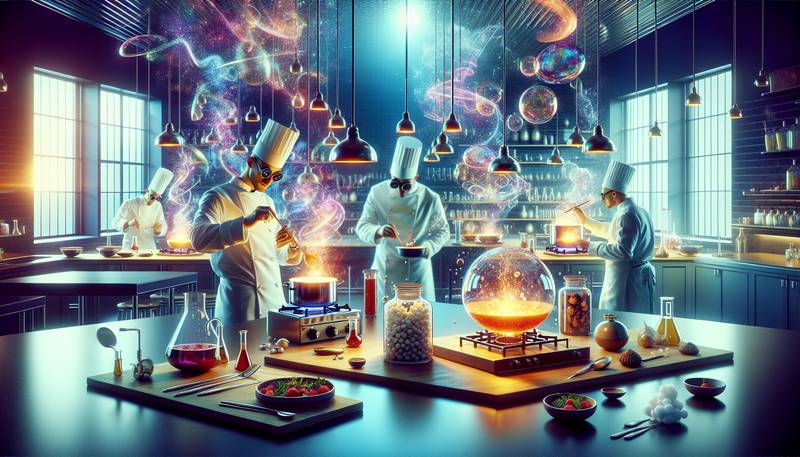Molecular Gastronomy: Science Meets Culinary Art

Introduction: The Magical World of Molecular GastronomyImagine yourself in a modern-day Hogwarts, where sorcerers in white coats concoct mind-boggling potions and elixirs. The air is thick with anticipation, as the knowledge that something extraordinary is brewing titillates your senses. Welcome to the world of molecular gastronomy, where science and culinary art blend in a fantastical dance, resulting in creations that defy the very laws of nature.A Brief History of Science in the KitchenThe origins of molecular gastronomy can be traced back to the 18th century, when the French chemist Antoine Lavoisier revolutionized the understanding of food and cooking. His pioneering work laid the foundation for future food scientists, such as the legendary Harold McGee, who deciphered the intricacies of heat, flavor, and texture in his seminal work 'On Food and Cooking: The Science and Lore of the Kitchen'.However, it wasn't until the late 20th century that molecular gastronomy truly took off, with culinary maestros like Ferran Adrià, Heston Blumenthal, and Grant Achatz pushing the boundaries of what was possible in the kitchen. Their daring experiments transformed dining into a multisensory experience, with dishes that looked, tasted, and felt like nothing that had come before.The Science Behind the SorceryAt its core, molecular gastronomy is the application of scientific principles to the art of cooking. By understanding the chemical and physical processes that occur during cooking, chefs can manipulate ingredients in innovative ways, producing textures, flavors, and visual spectacles that are a feast for the senses.Some common techniques used in molecular gastronomy include:- Spherification: The process of turning liquids into spheres with a gel-like consistency. This is often achieved by mixing a liquid with sodium alginate, and then dropping it into a calcium chloride solution. The result is a sphere with a liquid center, perfect for creating a surprising burst of flavor in the mouth.
- Emulsification: The combination of two immiscible liquids, such as oil and water, into a stable mixture. Chefs may use lecithin or other emulsifying agents to create new textures and mouthfeels. Emulsification can be used to create foams, airs, and sauces with unique consistencies.
- Cryogenic Cooking: The use of extremely low temperatures to freeze or cook ingredients. Liquid nitrogen is a popular tool in molecular gastronomy, allowing chefs to instantly freeze items, create ultra-smooth ice creams, or even shatter ingredients for dramatic presentations.
The Artful Side of Molecular GastronomyWhile the science behind molecular gastronomy is undeniably fascinating, it's the artistic aspect that truly sets it apart. Molecular gastronomy offers chefs an unprecedented level of control over every aspect of a dish, from the taste and texture to the visual presentation. This has led to the creation of some truly astonishing culinary masterpieces.Take, for example, the famous 'edible balloons' by Grant Achatz of Alinea in Chicago. These whimsical creations are made from green apple taffy filled with helium, and float above the table like delicate bubbles. To eat them, diners must carefully catch the fragile orbs with their mouths, resulting in a delightful burst of apple flavor that is as surprising as it is delicious.Or consider the 'botanical garden' dessert by Jordi Roca of El Celler de Can Roca in Spain. This intricate creation features edible 'soil,' made from chocolate and hazelnut, and 'plants' crafted from sugar, fruit, and other sweet ingredients. The result is a visually stunning, jaw-droppingly delicious dessert that perfectly encapsulates the spirit of molecular gastronomy.Practical Tips for Aspiring Molecular GastronomistsFeeling inspired to dabble in the dark arts of molecular gastronomy? You don't need a degree in chemistry or a state-of-the-art kitchen to get started. Here are some practical tips to help you bring a touch of science to your culinary endeavors:
- Start small: Begin by experimenting with a single technique or ingredient, such as spherification or emulsification. This will allow you to gain confidence and learn the basics before tackling more ambitious projects.
- Invest in quality ingredients and tools: The success of many molecular gastronomy techniques are closely tied to the quality of the ingredients and equipment used. Purchase high-quality ingredients, such as food-grade chemicals, and invest in the right tools, such as a digital scale and immersion blender.
- Don't forget about flavor: While the visual appeal of molecular gastronomy can be captivating, it's important to remember that flavor is paramount. Focus on creating dishes that not only look amazing but taste incredible too.
- Practice, practice, practice: As with any skill, mastering molecular gastronomy takes time and effort. Be prepared to experiment, fail, and try again in the pursuit of culinary greatness.
Conclusion: The Future of Molecular GastronomyAs the worlds of science and culinary art continue to intersect, the possibilities for molecular gastronomy are virtually limitless. From edible menus to color-changing cocktails, the innovations we've seen so far are merely the tip of the iceberg. One thing is certain: the future of molecular gastronomy is bright, and there's never been a more exciting time to be a culinary adventurer.
|
|







